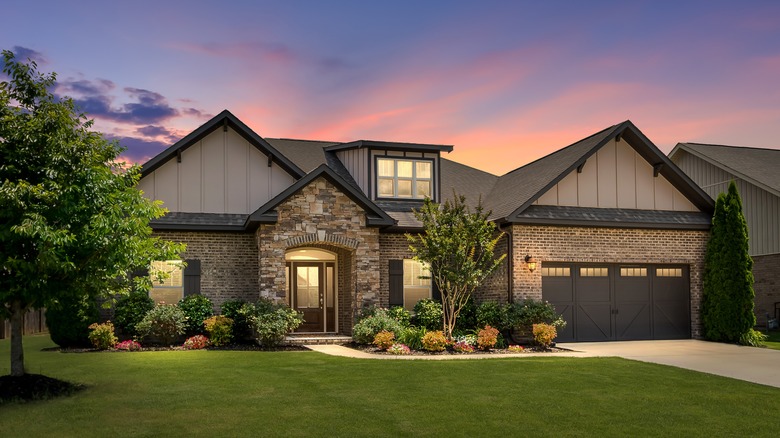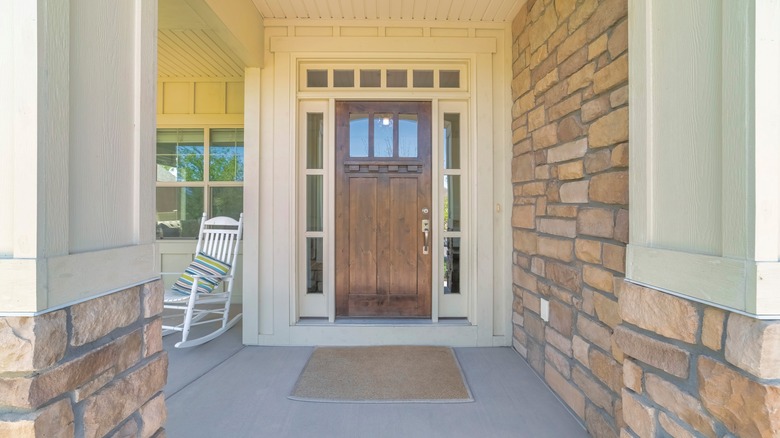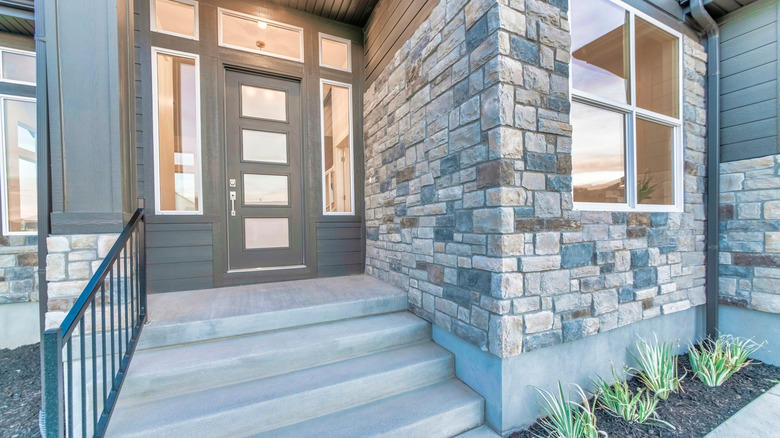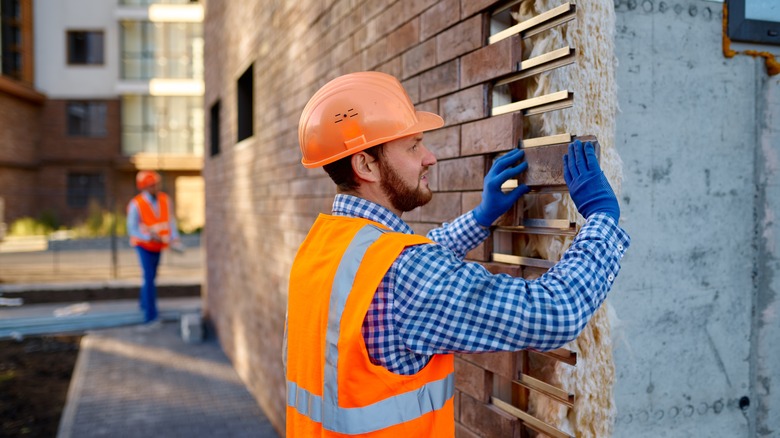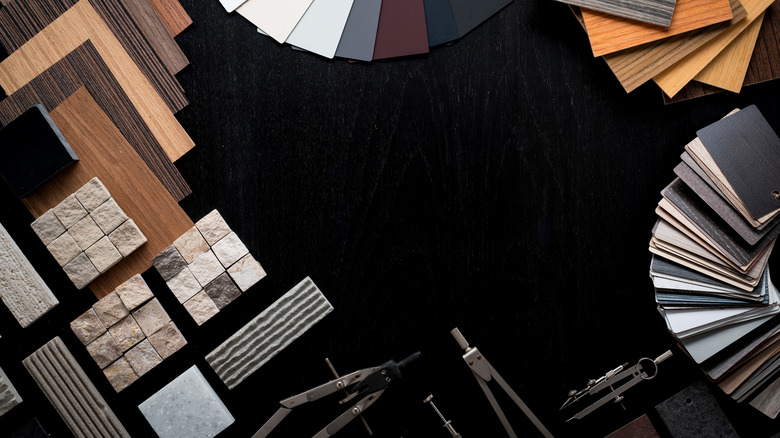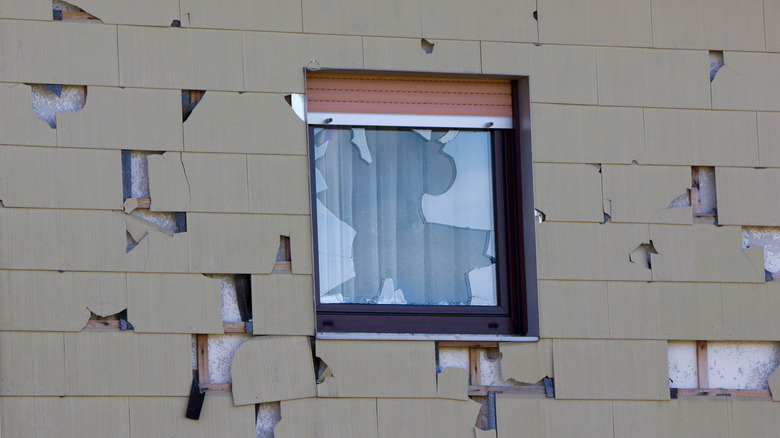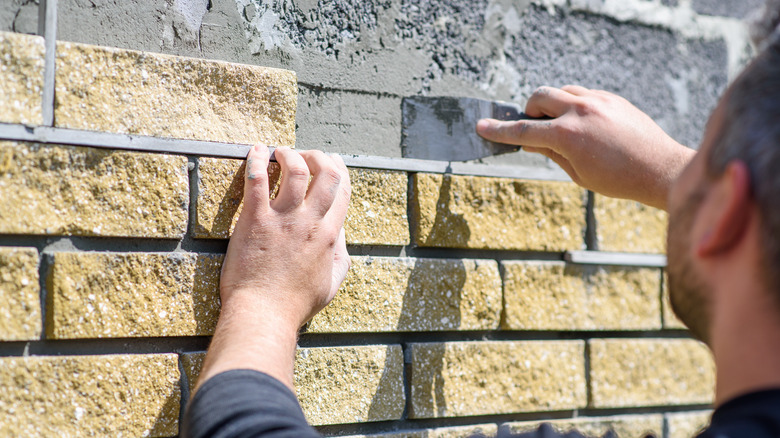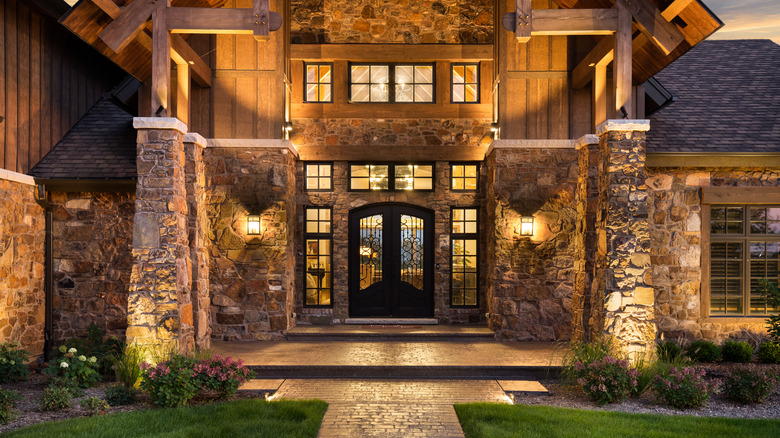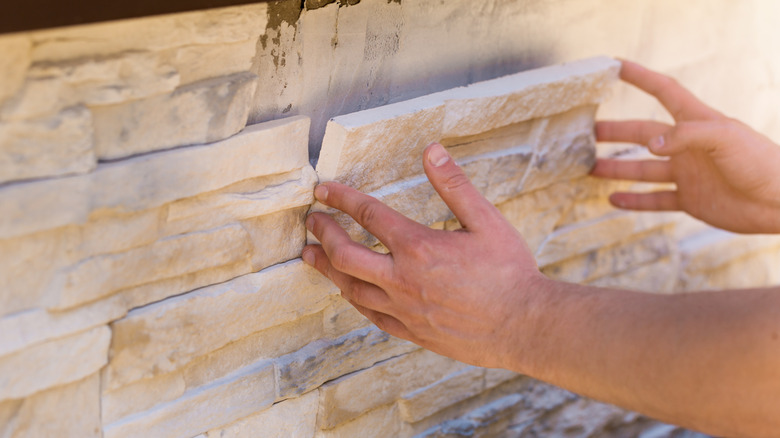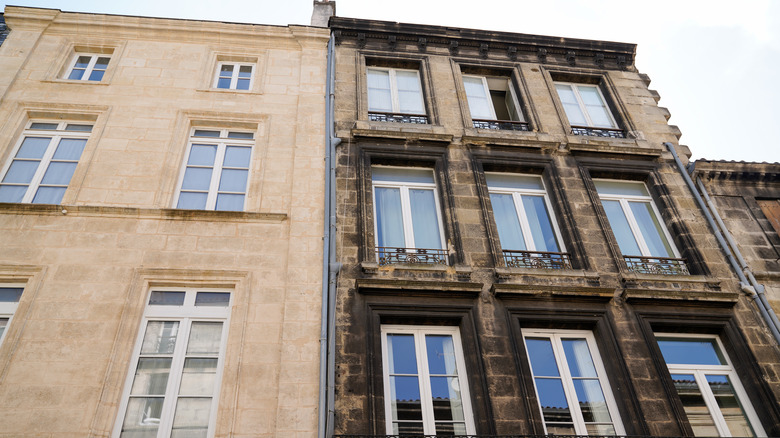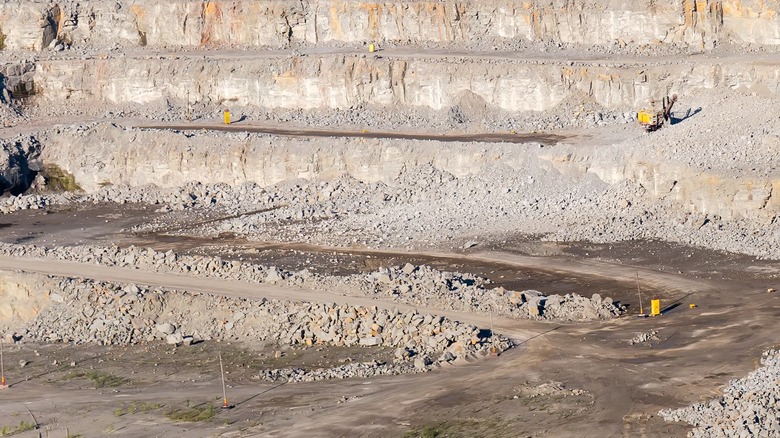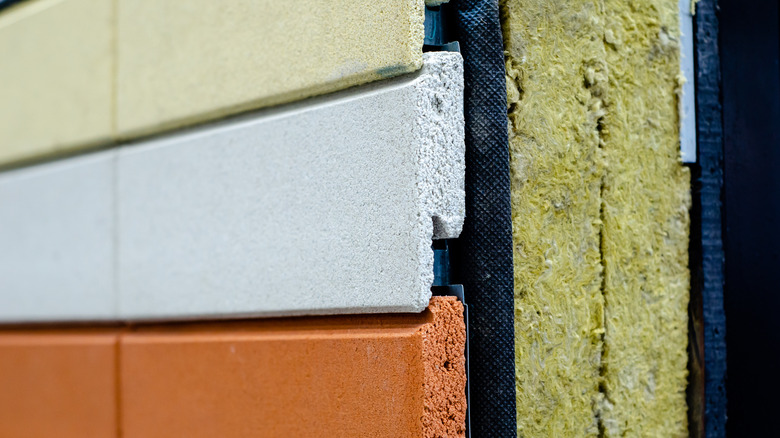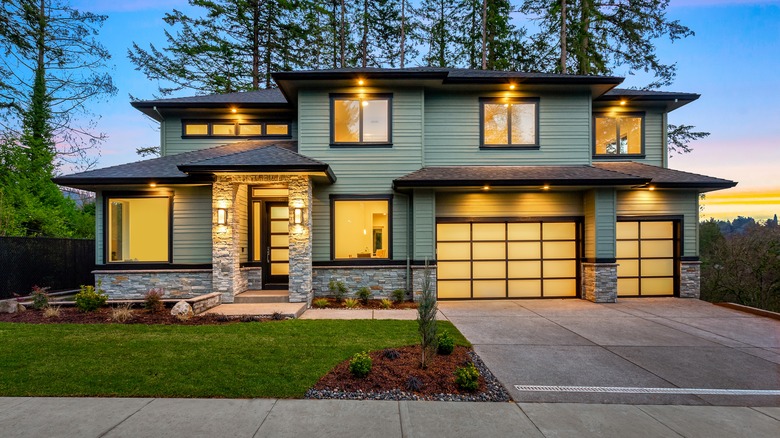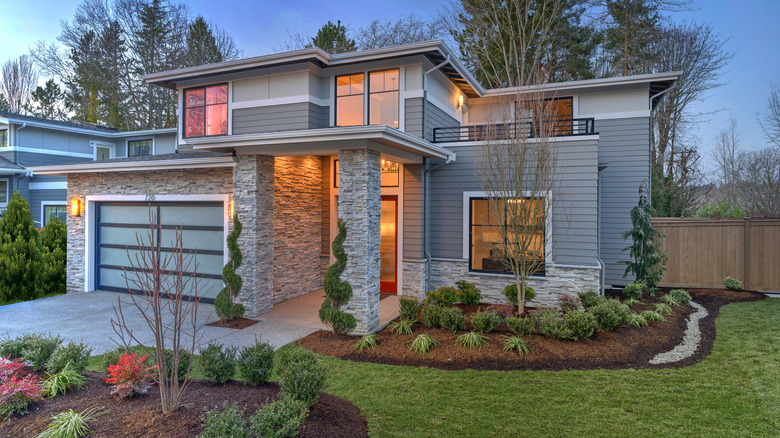Everything You Need To Know About Stone Cladding
Stone cladding is the introduction of a facade to a home or building using non-structural panels of thin stone. You've seen the look in Arts and Crafts homes, hunting and fishing stores, and the occasional dermatologist's office. You'll even see them installed indoors, possibly at your favorite coffee bar. These walls give the impression of stacked, mortared stone that people find beautiful in a timeless fashion. Let's take a close look at the good, the bad, and the expensive aspects of stone cladding.
We can start by getting a handle on what stone cladding is. Typically it involves creating a veneer or curtain wall that bears no weight but its own, according to the Whole Building Design Guide. Veneers are applied to an existing substrate like wall sheathing, while curtain walls tend to be self-supporting systems anchored to the existing structure in various ways. These components — the stone, support structure, and anchors — can be quite heavy. As a result, the strength of these systems under expected loads should be three to eight times the minimum necessary. If vinyl siding blows off a house, the structure might be in a sort of slow-motion danger involving mold or homeowners' associations, but if heavy stone panels loose themselves from their moorings, the risks are immediate and extreme. The need for professional installation of stone siding is on par with plumbing and maybe even electrical work.
The upsides of stone siding
The beauty of stone justifies the increased expense for many, especially considering the other benefits of stone, including durability, ease of maintenance, fire resistance, and (when it comes to natural stone) weather resistance, and improved resale value, according to Eco Outdoor. Manufactured stone has some advantages that reduce its installation costs. First and foremost, it's lighter — less than half as heavy (via Precision Contracting Services). This makes it more flexible as a building material in general, which means it can be used in more ways (or far more easily) than natural stone. It's also much less expensive, further extending its usefulness (via National Association of Realtors). Plus, manufactured stone is virtually indistinguishable from natural stone to the untrained eye ... and even to the trained eye, from a little distance.
With the right investment, most siding materials can match the stone's fire and weather resistance, durability, and resale value. But the best installation of the most expensive vinyl siding in the world will never match stone's aesthetic appeal, which is its one insurmountable advantage over the alternatives.
The downsides: Why to steer clear of stone cladding
There are some substantial negatives associated with stone veneers, and ultimately these come down to added construction costs. It's not just labor and materials to install the cladding; added expenses accrue by constructing or adapting the underlying structure that securely holds the cladding in place. The structural requirements help the cladding resist the natural forces of gravity, wind, and seismic load, according to CE Center. Design engineers account for these forces and related calculations, which installers must carefully respect. And natural stone must be properly installed, cleaned, and sealed to avoid moisture-related damage to the building or the cladding itself (via Eco Outdoor).
The requirements for manufactured stone are similar, if less dramatic. Manufactured stone panels are not watertight (no building material is), and improper installation can lead to potentially catastrophic moisture problems. Before moving forward with your wall update, you need to be prepared for and accept both potential issues.
Types of stone cladding
There are three fundamental types of stone cladding. Traditional handset cladding is usually set in courses like structural stone, but much thinner, says Architizer. A system of movement and compression joints allows for changes in size and position as weather changes. Rainscreen cladding, on the other hand, is often a much thinner stone veneer attached to the underlying structure by an anchorage system and usually includes a cavity for ventilation and channels for moisture removal.
Custom cladding, as you might imagine, is any material preparation that is purpose-built for a specific building or implementation. It can be made of unusual stone choices (such as brick, tile, or native stone), and it can serve a particular function not well-served by other options. Another useful way to categorize stone cladding is wet or dry. Wet cladding installation involves setting stone or stone panels in mortar directly on a substrate, while dry cladding panel installation secures the siding with a slip system.
Stone cladding materials and their characteristics
Stone veneer in any form has pros and cons related to the materials it's made of, the anchoring system it requires, and the various design choices it supports or enables. You also have to weigh the performance attributes of the cladding, which is generally superior to alternatives but is also susceptible to problems stemming from improper installation techniques.
Manufactured stone cladding is generally made of cement/concrete with an aggregate and pigment usually made of iron oxide. Some manufactured cladding is now made of polyurethane as well. Natural stone can be cut from basalt, bluestone, granite, Jerusalem stone, limestone, marble, onyx, sandstone slate, and others. Both are available in a wide range of colors, patterns, and textures, as per Stone Panels.
It has become increasingly important to recognize the environmental impact of materials. Natural stone offers excellent sustainability but engineered (manufactured) stone cladding enjoys some particular potential advantages in terms of energy efficiency (via Construction and Building Materials). Let's look at some of these characteristics in more detail.
Strength of stone cladding
The other key characteristic of stone cladding is its strength. While stone cladding isn't load-bearing in the usual sense of "bearing the weight of all the stuff above it," it does necessarily bear various loads. A paper presented to the Building Envelope Technology Symposium in 2008 describes the engineering investigation into a potentially harrowing failure in a marble panel installed in the 1970s. The language of engineers and scientists only thinly disguises the underlying human point that you really don't want marble falling on people.
The loads born by stone cladding include wind and seismic loads, missile impacts (usually the sorts of things that might get tossed around by strong winds), and even blast loads. Cladding strength also encompasses freeze-thaw durability and general durability over time. All of these forces are planned for and tested before the products hit stores (via Stone Panels).
What's involved with stone veneer installation?
Again, stone cladding is not a DIY project. Wet (or direct-adhered) installations are perhaps the most susceptible to failure from poor installation, but dry, mechanically attached installations are also highly skilled work that is demanding and expensive, according to Quality Marble's Natural Stone Cladding Guide For Architects.
Furthermore, it's not even the sort of work a residential construction professional will necessarily be familiar with. For typical wood-frame construction, direct adhered manufactured stone will also require a Water Resistive Barrier, lath and fasteners, mortar scratch coat and setting bed, a weep screed, and the stone veneer itself and its mortar (via Cultured Stone).
The installation process is complex, with variations and options for every contingency. For adhered manufactured stone veneer (AMSV), for example, the National Concrete Masonry Association produces a 77-page guide with 48 illustrations for every sheathing and framing combination, detailing every protrusion and penetration that might interrupt the veneer (via NCMA).
A mechanical installation is demanding in a different way. The fasteners for a dry installation are located and drilled precisely to ensure proper placement and avoid breaking the stone. The stone is not structurally mortared, so it's critical to place the dowels or other fasteners as described by the manufacturer. This work can go fast in the right hands, but, again, it's not suited for novices (via Quality Marble).
Why people bother: Design & aesthetics
Stone veneers have come into great demand despite only being commercially available for around 40 years. That's because people are drawn to the natural beauty, refinement, and (frankly) implied expense of stone cladding. It's also quite flexible. There are many colors and patterns and several finish textures (such as polished, honed, and sandblasted). Stone cladding supports many architectural styles, including Adirondack, Arts and Crafts, mountain architecture, Shingle, Storybook, and Tuscan architectural styles, among others, according to Hendricks Architecture.
In terms of the style of the stone itself, lots of approaches appear in stone cladding, including Artesia stone, country rubble, coursed stone, ledge stone, limestone, mountain ledge stone, natural stone, and stack stone (via McCoy Mart). Even though stone cladding isn't structural, it should give the appearance of support. This creates problems with many manufactured stone products, which are to be installed above grade and therefore often don't anchor the base of the building, which is visually disorienting.
There might be another somewhat less concrete reason we are drawn to stone. Jason F. McLennan, CEO of the International Living Future Institute, calls it "biophilia," and says that we are attracted to "elemental" materials in their simplest forms because we know they last. There is a part of us that understands that these are the building blocks of nature. This is how we build. This is how we have always built," he told BuildingGreen.
Performance of stone cladding
"Performance" seems an odd way to evaluate a wall, but it's simply a set of characteristics that include stone veneer's sustainability, durability, maintenance demands, and insulation value, among others. Several of these are interrelated, explains a paper written for the Technical University of Lisbon. Durability is quantified as "service life," which describes the amount of time a building meets its minimum performance requirements. Durability issues affect maintenance, of course, and preventive care is important to extending physical service life. And obviously, the degree to which a material is sustainable relates to how long it performs acceptably, in that a short service life would require more acquisition (via mining, etc.).
Researchers found that natural stone had a benchmark service life of 40 years (evaluated for general physical deterioration and color changes) or 64 years (evaluated for localized degradation). Manufacturers' warranties range from 20 to 75 years (via Be.On Stone). Research and warranties are probably the best places to get durability information about stone cladding, as the industry is full of hyperbolic language about the longevity and invincibility of natural stone.
Of course, the durability of natural stone is related to its density, which also affects how easy the material is to handle, cut, and install. This not only leads to high installation costs, but without careful execution, the weight can lead to degradation and even, on rare occasions, panel failure — the opposite of durability.
Maintenance: The easy part
Maintenance of natural and engineered veneer stone cladding largely comes down to careful cleaning. Harsh chemicals can damage both natural stone and manufactured stone veneers. Cleaning is further complicated by the fact that the use of pressure washers is generally discouraged, especially for manufactured stone. Fieldstone Veneer recommends cleaning natural stone with a mild detergent and a soft brush. It is always prudent to follow manufacturer recommendations if a specific cleaner (or type of cleaner) is mentioned. It's a good idea to wet the stone before applying a cleaner, preventing too much undiluted cleaner from being absorbed by the stone.
General cleaning instructions for manufactured stone veneer are similar: Clean with only a light spray of water first, and if necessary, use a mild detergent with a soft brush (via ProVia). Avoid wire brushes and acids, including vinegar. If a sealer is recommended for either type of product, carefully follow the instructions from both the stone veneer manufacturers and the sealer.
Sustainability of stone cladding
The sustainability of stone cladding comes from its durability and its reusability. Natural stone is nearly 100% recyclable. Recent improvements in mining practices and environmental monitoring have vastly improved the impact of quarries in the past two decades (via the Natural Stone Institute). The "greenness" of natural stone is further enhanced by other properties, including that it usually doesn't emit VOCs and requires virtually no chemicals to produce. BuildingGreen contrasts this with engineered products, some of which can be awash in petrochemicals (particularly the manufactured stone made of polyurethane) and the individual components that often require global transportation.
Manufactured stone has its own proponents who champion its environmental suitability. They argue that the environmental impact of engineered stone is lower because of the reduced reliance on destructive quarrying and the lower energy costs associated with transporting lighter-weight materials. And compared with plastic, vinyl, or treated wood siding, manufactured stone is far less reliant on chemicals during the manufacturing process (via Casa di Sassi).
Insulation of cladding
The insulation properties of natural stone are often extolled in sales and technical literature, but Texture Plus says that stone is not a good insulator but rather a thermal mass that can store heat. Predictably, this is more beneficial during cold months than when it's hot out. The Natural Stone Council's case study "Natural Stone Solar Reflectance Index and the Urban Heat Island Effect" explains that heat absorption increases cooling costs and, therefore, environmental impact.
So what's the upshot of all this? Let's look at some numbers. Thermal insulators ideally have low thermal conductivity per inch, expressed in an "R-value per inch," with higher values being better. Among common building insulation materials, fiberglass batt insulation has an R-value per inch of 2.9 to 3.8, stone wool batt from 3.3 to 4.2, loose cellulose from 3.1 to 3.8, and closed-cell foam from 5.6 to 8.0 (via Today's Homeowner). Under ideal circumstances, stone has per-inch R-values ranging from .027 (Quartzite) to .114 (Limestone) via the Natural Stone Institute. The R-value per inch of manufactured stone siding is usually in the neighborhood of .41 per inch (via Improvement Center). Keep in mind that walls are insulated independent of cladding, so this isn't an either/or situation, and cladding adds R-value to your existing insulation. In fact, the cladding system as a whole adds R-value, as much as 4 or 5 to the overall wall's R-value.
Still, in terms of bang for your buck, stone cladding has clearer benefits than its insulation properties. For context, batt fiberglass insulation in a modern 2x4 wall might have a total R-value of 15, and it costs $1 per square foot or less. So it might make sense to focus instead on the other benefits like weatherproofness, fireproofness, improved resale value, and attractiveness.
Cost of cladding
So what are you paying for that weatherproofness, fireproofness, resale value, and attractiveness? Stone cladding costs are all over the map, with a major gap between the expense of natural stone versus cheaper manufactured stone. Nationally, installed per-square-foot costs range between $5 (cheaper manufactured stone) and $48 (pricier natural stone), according to Modernize Home Services. Stone siding installation costs range from $30,000 to $50,000, with a national average of $37,500 (via Fixr). Obviously, if you are considering stone siding, your job will be unique, and your costs will differ from this average, possibly by a lot.
Incidentally, both Fixr and Modernize throw "faux stone" into the mix when discussing pricing. Faux stone usually describes a molded foam product that looks remarkably like natural stone and can be installed by a DIYer. But we've disregarded faux stone in our discussion because it lacks some of the key durability characteristics fundamental to a discussion of stone siding. All that it really has in common with stone is its appearance.
So, should I use it or not?
When reading about stone building products, you'll occasionally come across grand claims about historical ruins that imply, or outright assert, that the Roman coliseum or some other impressive rubble is proof of the longevity of stone. And, true enough: Stone is durable. Stone buildings are somewhat less durable, though. Hendricks Architecture comes right out and says it: Stone isn't a good structural building material that fails under some loads, such as seismic events. Building methods have moved well beyond stone structures.
What survives, though, is an impression of solidity created by stone. So, get this: By creating the impression of solid rock while being integrated into actually strong modern buildings, stone cladding manages to be both an illusion and the real thing.
So, there's no question that it's superior to actual structural stone, but at what cost? Set against other cladding and siding options, both natural and manufactured stone can be quite expensive, and expense is probably the first consideration in deciding whether to use it. After squaring away the finances, your decision about which stone cladding to use will depend on the answers to many questions. How much sun, shade, and moisture will your building contend with? What are the temperature extremes it'll face? What are your existing walls made of, and how tall are they? Carefully installed, the broad category of "stone cladding" can accommodate all these intricacies with a change in materials here and a tweak to building method there (via Armstone).
But you won't get stone cladding as cheap, effective, or reliable as some other siding methods. Certainly, it can be reliable, but it's not your safest bet. Manufacturers of competing products will occasionally make bold, broad claims that stone siding undermines the entire point of siding by giving moisture a path of ingress into your walls. This is overstated, but there's a grain of truth to it. So the safest possible installation of an expensive material makes it even more costly, and that's the premium you pay for your real motivation: Stone walls, whether real or not, are absolutely gorgeous.
